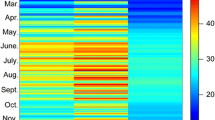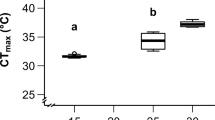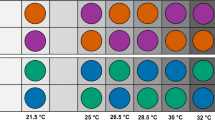Abstract
The temperature tolerance and resistance times of postlarval (<25 mm SL) and small juvenile spot,Leiostomus xanthurus, from the Cape Fear Estuary, North Carolina were tested in the laboratory. Critical thermal maximum techniques were used to determine first equilibrium loss (FEL) and critical thermal maximum (CTM) end points and thermal shock methods were used to determine 96-h upper incipient lethal temperatures (LT50). Acclimation temperatures ranged from 10 to 35°C and acclimation salinities were 10, 20 and 30‰. A quadratics model was fit to the CTM and FEL data; r2 values were 0.924 and 0.928 respectively. Acclimation salinity, estimated weight, acclimation salinity by acclimation temperature interaction and acclimation temperature by estimated weight interaction were the significant components of the CTM model. Predicted CTM values ranged from 30°C at 10 °C and 30‰ acclimation to just over 40°C at 30 °C and 30‰ acclimation.
Acclimation temperature, acclimation temperature squared, estimated weight and acclimation temperatures by estimated weight interaction were the significant components of the FEL model. Predicted FEL values ranged from around 28°C at 10°C and 10‰ acclimation to about 39°C at 30°C and 30‰ acclimation.
The 96-h LT50 values of spot acclimated to 20‰ increased linearly with acclimation temperature to 25°C. From about 25 to 35°C, LT50 values increased very little with acclimation temperature. The ultimate upper incipient lethal temperature of postlarval and small juvenile spot was estimated at 35.2°C. Increased salinity increased resistance time but decreased LT50 estimates. Thermal shock tests were better for predicting the effects of thermal addition than were CTM tests.
Similar content being viewed by others
Literature Cited
Birkhead, W. S., C. R. Bennett, E. C. Pendleton, and B. J. Copeland. 1977. Nursery Utilization of the Dutchman Creek Estuary, N.C., 1971–1976. Report to Carolina Power & Light Co., Raleigh, N.C., 258 p.
Brett, J. R. 1946. Rate of gain of heat tolerance in goldfish (Carassius auratus).University Toronto Stud. Biol. Ser., No. 52. (Pub. Ont. Fish. Res. Lab., No. 64), 9–28.
Brett, J. R. 1952. Temperature tolerance in young Pacific Salmon, genusOncorhynchus.J. Fish. Res. Board Can. 9:265–323.
Bridges, D. W. 1971. The critical thermal maximum of juvenile spotLeiostomus xanthurus Lacépède.Water Resources Res. Inst. Rep. No. 43, 39 p.
Coutant, C. C. 1970. Biological aspects of thermal pollution. I. Entrainment and discharge canal effects.Chem. Rubber Co. Crit. Revs. in Environmental Control 1:341–381.
Coutant, C. C. 1971. Effects on organisms of entrainment in cooling water: Steps toward predictability.Nucl. Saf. 12:600–607.
Copeland, B. J., R. G. Hodson, and R. J. Monroe. 1979. Larvae and post-larvae in the Cape Fear River Estuary, N.C. during operation of the Brunswick Steam Electric Plant 1974–1978. Report 79-3 to Carolina Power & Light Co., Raleigh, N.C. 203 p.
Cowles, R. B., andC. M. Bogert. 1944. A preliminary study of the thermal requirements of desert reptiles.Bull. Am. Mus. Nat. Hist. 83:265–296.
Cox, D. K. 1974. Effects of three heating rates on the critical thermal maximum of bluegill.Proc. Thermal Ecology Symp., pp. 158–163.
Dawson, C. E. 1958. A study of the biology and life history of the spot,Leiostomus xanthurus Lacépède, with special reference to South Carolina.Contr. Bears Bluff Lab. No. 28, 48 p.
Doudoroff, P. 1942. The resistance and acclimation of marine fishes to temperature changes. I. Experiments withGirella nigricans (Ayres).Biol. Bull. 83:219–244.
Edsall, T. A., andP. J. Colby. 1970. Temperature tolerance of young-of-the-year cisco,Coregonus artedii.Trans. Am. Fish Soc. 99:526–531.
Fry, F. E. J. 1947. Effects of the environment on animal activity.Univ. Toronto Stud. Biol. No. 55 (Pub. Ont. Fish Res. Lab. 68), 1–62.
Fry, F. E. J., J. R. Brett, andG. H. Clawson. 1942. Lethal limits of temperature for young goldfish.Rev. Can. Biol. 1:50–56.
Fry, F. E. J., J. S. Hart, andK. F. Walker. 1946. Lethal temperature relations for a sample of young speckled trout (Salvelinus fontinalis).Univ. Toronto Stud. Biol. Ser., No. 54 (Pub. Ont. Fish Res. Lab. 66), 9–35.
Hartwell, S. I. 1976. The effect of cycling acclimation temperature on the thermal shock resistance of postlarval and juvenile spot,Leiostomus xanthurus Lacépède. M.S. Thesis, N.C. State Univ., Raleigh, North Carolina, 25 p.
Hoar, W. S. 1956. Photoperiodism and thermal resistance of goldfish.Nature 178:364–365.
Hoar, W. S., andG. B. Robertson. 1959. Temperature resistance of goldfish maintained under controlled photoperiods.Can. J. Zool. 37:419–428.
Horton, D. B., andD. W. Bridges. 1969. Ecological systems receiving heated water, p. 1113–1147.In H. T. Odum, B. J. Copeland and E. A. McMahan (eds.), Coastal Ecological Systems of the United States, The Conservation Foundation, Washington, D.C.
Hoss, D. E., L. C. Coston, andW. F. Hettler, Jr. 1971. Effects of increased temperature on postlarval and juvenile estuarine fish.Proc. SE Assoc. Game & Fish Commnrs. 25:635–642.
Hoss, D. E., W. H. Hettler, Jr., andL. C. Coston. 1974. Effects of thermal shock on larval estuarine fish-ecological implications with respect to entrainment in power plant cooling systems, p. 357–371.In J. H. S. Blaxter (ed.), The Early Life History of Fish, Springer-Verlag, Berlin, Heidelberg and New York.
Huntsman, A. G., andM. I. Sparks. 1924. Limiting factors for marine animals. 3. Relative resistance to high temperature.Centri. Can. Biol. N. S. 2:95–114.
Hutchison, V. H. 1961. Critical thermal maximum in salamanders.Physiol. Zool. 34:92–125.
Laney, R. W. 1973. A comparison of the critical thermal maxima of juvenile brown shrimp (Penaeus aztecus aztecus Ives) and white shrimp (Penaeus setiferus (Linnaeus). M.S. Thesis, N.C. State Univ., Raleigh, North Carolina, 40 p.
Litchfield, J. T., Jr., andF. Wilcoxon. 1949. A simplified method of evaluating dose-effect experiments.J. Pharmacol. Exp. Ther. 95:99–113.
Lowe, C. H., andV. J. Vance. 1955. Acclimation of the critical thermal maximum of the reptileUrosaurus ornatus.Science 122:73–74.
Mazeaud, M. M., F. Mazeaud, andE. M. Donaldson. 1977. Primary and secondary effects of stress in fish: some new data with a general review.Trans. Am. Fish Soc. 106:201–211.
Mihursky, J. A., andV. S. Kennedy. 1967. Water temperature criteria to protect aquatic life.Am. Fish Soc., Spec. Publ. 4:20–32.
Nakano, T., andN. Tomlinson. 1967. Catecholamine and carbohydrate concentrations in rainbow trout (Salmo gairdneri) in relation to physical disturbance.J. Fish Res. Board Can. 24:1701–1715.
Otto, R. G., M. A. Kitchel, andJ. O. Rice. 1976. Lethal and preferred temperature of the alewife (Alosa pseudoharengus) in Lake Michigan.Trans. Am. Fish Soc. 105:96–106.
Parker, J. C. 1971. The biology of the spot,Leiostomus xanthurus Lacépède, and Atlantic croaker,Micropogon undulatus (Linnaeus), in two Gulf of Mexico nursery areas. Sea Grant Publ. No. TAMU-56-71-210, 182 p.
Snedecor, G. W., andW. G. Cochran. 1967. Statistical Methods. Iowa State University Press, Ames, Iowa, U.S.A., 593 p.
Stevens, E. D., andF. E. J. Fry. 1970. The rate of thermal exchange in a teleost,Tilapia mossambica.Can. J. Zool. 48:221–226.
Stevens, E. D., andF. E. J. Fry. 1974. Heat transfer and body temperature in non-thermoregulatory teleosts.Can. J. Zool. 52:1137–1143.
Strange, R. J., C. B. Schreck, andJ. T. Golden. 1977. Golden certicord stress response to handling and temperature in salmonids.Trans. Am. Fish Soc. 106:213–217.
Wedemeyer, G. 1973. Some physiological aspects of sublethal heat stress in juvenile steelhead trout (Salmo gairdneri) and coho salmon (Oncorhynchus kisutch).J. Fish. Res. Board Can. 30:831–834.
Weinstein, M. P. 1979. Shallow marsh habitats as primary nurseries for fishes and shellfish, Cape Fear River, North Carolina.Fish Bull. 77:339–358.
Author information
Authors and Affiliations
Rights and permissions
About this article
Cite this article
Hodson, R.G., Fechhelm, R.G. & Monroe, R.J. Upper temperature tolerance of spot,Leiostomus xanthurus, from the cape Fear River estuary, North Carolina. Estuaries 4, 345–356 (1981). https://doi.org/10.2307/1352159
Issue Date:
DOI: https://doi.org/10.2307/1352159




